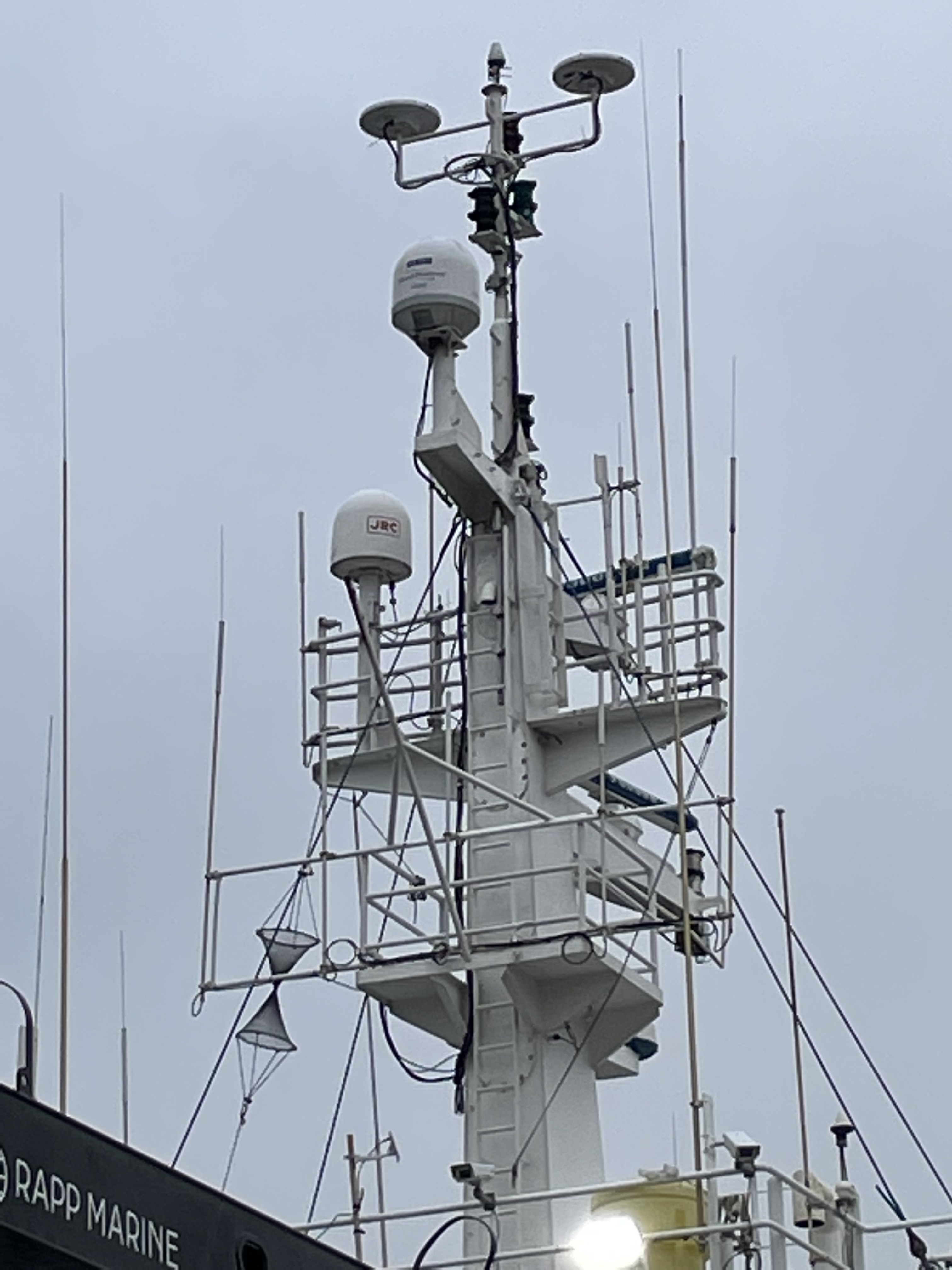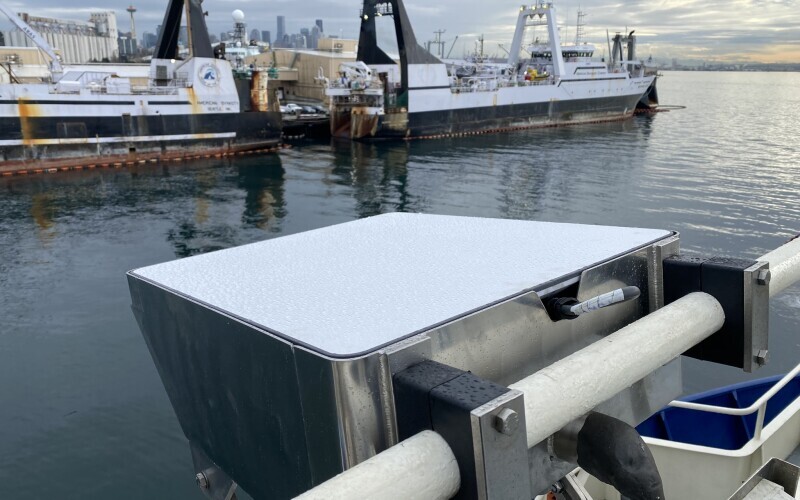Satcom companies around the world are adjusting to the impact of Starlink on the Satcom market.
In 2023, SpaceX's Starlink subsidiary introduced high-bandwidth, low-cost satellite communication, or satcom, as a new option for commercial fishing and other marine users. “Since then, everyone else is trying to find their place in a new world,” says Ron Wright, director of commercial and government sales at OCENS, a Washington-based all-around satcom provider. “Ten years ago, I would have told you that the Satcom industry is very static. Not anymore; now I’d call it dynamic and likely to stay that way.”
As Starlink becomes the satellite communications company of choice on most fishing vessels, from 32-foot Bristol Bay gillnetters to 300-foot freezer trawlers and everything in between, longtime satellite companies and service providers are adjusting their business models and technology. The Rhode Island-based KVH, for example, announced a “strategic realignment of resources and corporate restructuring” in a press release last year. KVH described its plan to wind down its hardware manufacturing operations and position itself to become a “leading solutions-driven provider of integrated multi-orbit, multi-channel connectivity.”
According to David Tolley, chairman of KVH, the “announcement is the culmination of the board’s extensive examination for how to best position KVH for the future as our markets continue to evolve. We have concluded that the company should migrate away from capital-intensive manufacturing to become a more agile sales and service-oriented organization, using our expertise and global reach to deliver exceptional value-added solutions to the end markets we serve. We believe this adjustment will enable us to leverage our strong reputation, customer relationships, and technology in a more flexible and sustainable manner going forward.”
Starlink’s LEO (Low Earth Orbiting) satellites offer greater coverage and lower latency compared with the geostationary orbit satellites that KVH uses for its VSAT service,asccording to a story by Space News. KVH announced in June 2024 that it had purchased access to a significant segment of Starlink data as part of a bulk distribution deal.
"Existing Starlink customers can migrate their service to KVH to take advantage of the improved care and shipping flexibility they offer,” says Wright. When fishermen opt to access Starlink through KVH, they reportedly receive more specialized customer and technical services compared to Starlink’s minimalist customer service experience. KVH will also help customers integrate Starlink with 5G networks and satellites in other orbits. While its VSAT sales continue declining, KVH has completed more than 1,000 Starlink installations in 2024 and supports the systems.
Handheld Backup

"Starlink does not meet safety at sea requirements and should be backed up by an approved satellite SOS provider,” says Wright. He notes that compact handheld text-only devices like the Garmin inReach, the ACR Bivy Stick, and the Zoleo Satellite Communicator have long been used by individual crew members and captains of small boats and continue to be held in reserve in case of problems with Starlink.

Wright notes that ACR has just introduced a LoRa mesh network device, the Bivy Stick Mesh, which creates a terrestrial local network of near devices to handle local messaging relays adjacent to the Iridium satellite connection. “This mesh network can allow one mesh-connected device that has satellite connectivity to receive relays from devices out of satellite view but within LoRa range,” he says. “Think of one on the console of the vessel and one deeper inside a vessel, such as the engine room or crew quarters. Or a group of fishing vessels relaying to the unit with the best satellite connectivity.”
According to Wright, ACR’s Bivy Stick Mesh operates in a spectrum that does not require a license and has a growing number of marine applications. “LoRa sensors could be used to monitor water temperature, salinity, pH levels, and other parameters,” he says. “Sensors could also track wave heights, direction, and current speeds, and aid in navigation and weather forecasting.”
Wright notes that from a regulatory and fishing operations perspective, LoRa Mesh could provide greater resolution of fishing gear use, including location, time of launch and recovery, as well as activation of winch and net reels.

Garmin has responded to the new playing field with the introduction of the inReach Messenger Plus, which “has all the features of the original inReach and gives users the ability to send photo and voice messages even beyond cell service,” says Garmin’s associate director of public relations, Carly Hysell. “With a battery life that can last for weeks, this two-way satellite communicator also has two-way texting, location sharing, and SOS capabilities, and in the event of an emergency, the inReach Messenger Plus and Garmin Messenger app can send an interactive SOS text message to Garmin Response, a 24/7-staffed international emergency assistance coordination center. Photo and voice messages can also be shared during an SOS, giving response coordinators the ability to see and hear details of the emergency firsthand.”
Hysell adds that inReach Messenger Plus uses pole-to-pole 100% global Iridium satellite coverage to provide seamless and reliable satellite communication as a standalone device or when paired to the Garmin Messenger mobile app on a compatible smartphone.
"The inReach Messenger Plus will be available at the time of launch for $499.99; an active satellite subscription is required to communicate using an inReach Messenger Plus and plans are available starting at $14.99/month,” says Hysell.
Wright notes that Iridium has increased its satellite bandwidth from 2.4 Kbps to 22 Kbps and more up and down. “Iridium's new Certus chipset and IMT protocol offers configurable packets that make better use of bandwidth,” he says. “The Garmin InReach Messenger Plus is the only unit currently taking advantage of this service, though I expect that ZOLEO and Bivy will follow suit in the future.”

Satellite to Cell
As the satellite industry develops mixed-network systems to combine capabilities of terrestrial, satellite, and direct to device solutions, Globalstar's TLPS—Terrestrial Low-Power Service—is out in front as an example of combining satellite spectrum with existing terrestrial Wi-Fi technology for higher bandwidth throughput and in-building connectivity. “The application of this technology requires FCC approval by country and region,” says Wright. “It also requires billing systems to recognize a diverse mix of connectivity paths.”

Apple has invested $1 billion into Globalstar’s C-3 project, in which Globalstar plans to launch 48 new low-Earth orbit satellites. Globalstar has petitioned the Federal Communications Commission (FCC) for a declaratory ruling that would grant it U.S. market access. In a March 2025 filing with the FCC, Globalstar indicated that its new satellite technology would improve connectivity in buildings and vehicles, including vessels.
But SpaceX founder Elon Musk is reportedly lobbying the Federal Communications Commission (FCC), asking it to stop Globalstar and Apple from going forward with the satellite spectrum cell phone link. The radio bands that Globalstar will use are facing scrutiny at the FCC, which is considering opening up the spectrum to all satellite players, following a request from SpaceX, which calls Globalstar’s application “premature,” and urges the FCC to first open up the radio bands for sharing among mobile satellite services.
In its filing to the FCC, Globalstar said it has been working on its C-3 satellite system since October 2023. Under the deal with Apple, Globalstar is allocating 85 percent of its network capacity for Apple services. “The C-3 System deployment is vital for the emergence of Globalstar’s advanced commercial/enterprise IoT [Internet of Things], and consumer-based MSS [Mobile Satellite Service] offerings, as well as an essential foundation for a variety of new, innovative direct-to-device satellite features on supported devices, such as Apple’s iPhones,” Globalstar said.
Wright adds that the IoT is becoming an increasing part of fishing vessel operations. “It’s being used to remotely control things like engine performance, and more,” he says.
Globalstar also argued in its filing that its higher power system is necessary “to remain competitive with future offerings that take the approach of supplemental coverage from space – in which satellites use terrestrial spectrum versus satellite spectrum.”
A Starlink Alternative
Another new player with potential in the market is OneWeb. “OneWeb has officially launched in the marine market,” says Wright. “Hardware prices are higher than Starlink, around $10,000 for half duplex and $20,000 for full duplex models, versus the $2,500 retail for the Starlink high-performance antenna. The OneWeb antennas are specifically designed for maritime use and also offer CIR (committed information rate) plans that provide a service level agreement (SLA) of a specified and promised throughput.”
While OneWeb’s hardware costs are higher, Wright points out that the price of the company’s standard retail service plans will be comparable to Starlink’s. “For customers wishing to avoid the politics of Elon Musk, this may be the best alternative and certainly a better commercial solution. He says that KVH offers "OneWeb service and customer care overlay for better customer service support."
As Wright repeatedly points out, the once slow developing satcom market has become very dynamic, bringing new technologies and players to the field and offering more satcom capacity to vessel owners and crew.






